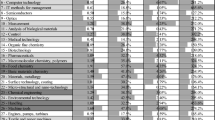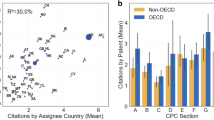Abstract
Scientific, technological, and economic data are investigated for 128 countries. A stepwise regression analysis is carried out on the data, using domestic patent counts as the dependent variable. The form of the regression equations is the Cobb-Douglas production function. The analysis shows that domestic patents (as indicator of national technological capacity, and treated here as the dependent variable) are closely related to GNP (a measure of national economic size), counts of scientific publications (an indicator of scientific capacity), and counts of national patents obtained in the U.S. (a measure of world class technological capacity). Together, these three independent variables account for more than 92 percent of the variance in the dependent variable.
Similar content being viewed by others
References
For example seeM.P. Carpenter, F. Narin, P. Woolf,World Patent Information, 3 (1981) 160;K. Pavitt, R&D patenting and innovative activities: A statistical exploration,Research Policy, 11 (1982) 000; andP. Patel, K. Pavitt, Measuring Europe's technological performance: Results and prospects, in:H. Ergas (Ed.),A European Future in High Technology? (Center for European Policy Studies, Brussels, 1986).
International Intellectual Property Alliance,Piracy of U.S. Copyrighted Works in Ten Selected Countries, Washington, D.C., 1985.
U.S. International Trade Commission,The Effects of Foreign Product Counterfeiting on U.S. Industry, Final Report on Investigation No. 332-158 under Section 332(b) of the Tariff Act of 1930 (1984), appearing inPatent and Trademark Review, Vol. 82, No. 11 (November 1984), 471-185; Vol. 82, No. 12 (December 1984), 518–522; and Vol. 83, No. 1 (Jan–Feb 1985), 20–40.
Found in a presentation by Gerald J.Mossinghoff, Presentation to the Japan Pharmaceutical Manufacturers Association, Seminar on Intellectual Property Prection from a Global Perspective (January 20, 1987).
T.C. Creel, D.M. Wintringham, Patent system and their role in the technological advance of developing nations,Rutgers Computer and Technology Law Journal, 10 (1984), Table 1, 295–96; also,H.P. Kunz-Hallstein, The revision of the international system of patent protection in the interest of developing countries,IIC International Review of Industrial Property and Copyright Law, 10 (1979) 000.
A. Smith,The Wealth of Nations, (New York, The Modern Library, 1937).
U.S. Constitution, Article 1, Section 8.
H.A. Meier, Thomas Jefferson and a democratic technology, in:C.W. Pursell, Jr., (Ed.),Technology in America, Cambridge, MA, MIT Press, 1981.
R. Solow, Technical change and the aggregate production function,Review of Economics and Statistics, 29 (1957) 000.
E.F. Denison,The Sources of Economic Growth in the United States, New York, Committee on Economic development, 1962.
A. Carter, The economics of technological change,Scientific American, 214 (1966) 000.
Z. Griliches, The sources of measured productivity growth: United States agriculture, 1940–60,Journal of Political Economy, 331 (August 1963).
J. Schmookler,Invention and Economic Growth, Cambridge, MA, Harvard University Press, 1966.
J.D. Frame, National economic resources and the production of research in lesser developed countries,Social Studies of Science, 9 (1979) 233–46.
Author information
Authors and Affiliations
Rights and permissions
About this article
Cite this article
Frame, J. Modelling national technological capacity with patent indicators. Scientometrics 22, 327–339 (1991). https://doi.org/10.1007/BF02019766
Received:
Issue Date:
DOI: https://doi.org/10.1007/BF02019766




